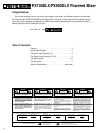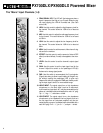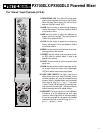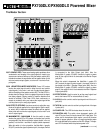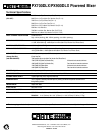
4
1. PEAK/SIGNAL LED: This LED will illuminate green when a
signal is present at the High or Low Z inputs. When the sig-
nal nears clipping, the LED will illuminate red. (See Gain
control, #8.)
2. HIGH: Use this control to adjust the high frequency level for
the channel. This control allows for 15dB of cut or boost at
12kHz.
3. MID: Use this control to adjust the midrange frequency level
for the channel. This control allows for 15dB of cut or boost
at 2.5kHz.
4. LOW: Use this control to adjust the low frequency level for
the channel. This control allows for 15dB of cut or boost at
80Hz.
5. MON: Use this control to set the amount of the channel’s sig-
nal sent to the monitors.
6. EFFECT: Use this control to set the amount of internal DSP
effect (or external effects, if used) to be applied to the chan-
nel.
7. LEVEL: Use this control to set the channel’s output signal
level.
8. GAIN: Use this control to set the input signal level for the
channel. Adjust this control so the peak/signal LED (#1)
flashes red on strong signal peaks.
9. PAD: Use this switch to accommodate “hot” input signals.
(Signals too strong to allow a useful setting of the gain con-
trol without causing the peak/signal LED to glow red.)
Depress this switch to engage the 20dB pad, thereby reduc-
ing the input signal’s level to a more useable range.
10. HIGH Z INPUT: The signal output from a high impedance
microphone or a line level signal (such as an instrument,
rhythm machine, tape deck, etc.) may be connected here by
means of a shielded cable terminated with a male 1/4” plug.
Tip = “+,” ring = “–,” and sleeve = shield.
11. LOW Z INPUT: The signal output from a low impedance
microphone or a low impedance line level signal (such as a
line out signal from an instrument amplifier) may be con-
nected here by means of a shielded cable terminated with a
male XLR plug. Pin 2 = “+,” pin 3 = “–,” and pin 1 = shield.
PX700DLX/PX900DLX Powered Mixer
The “Mono” Input Channels (1-4):
1
2
3
4
5
6
7
8
9
10
11




